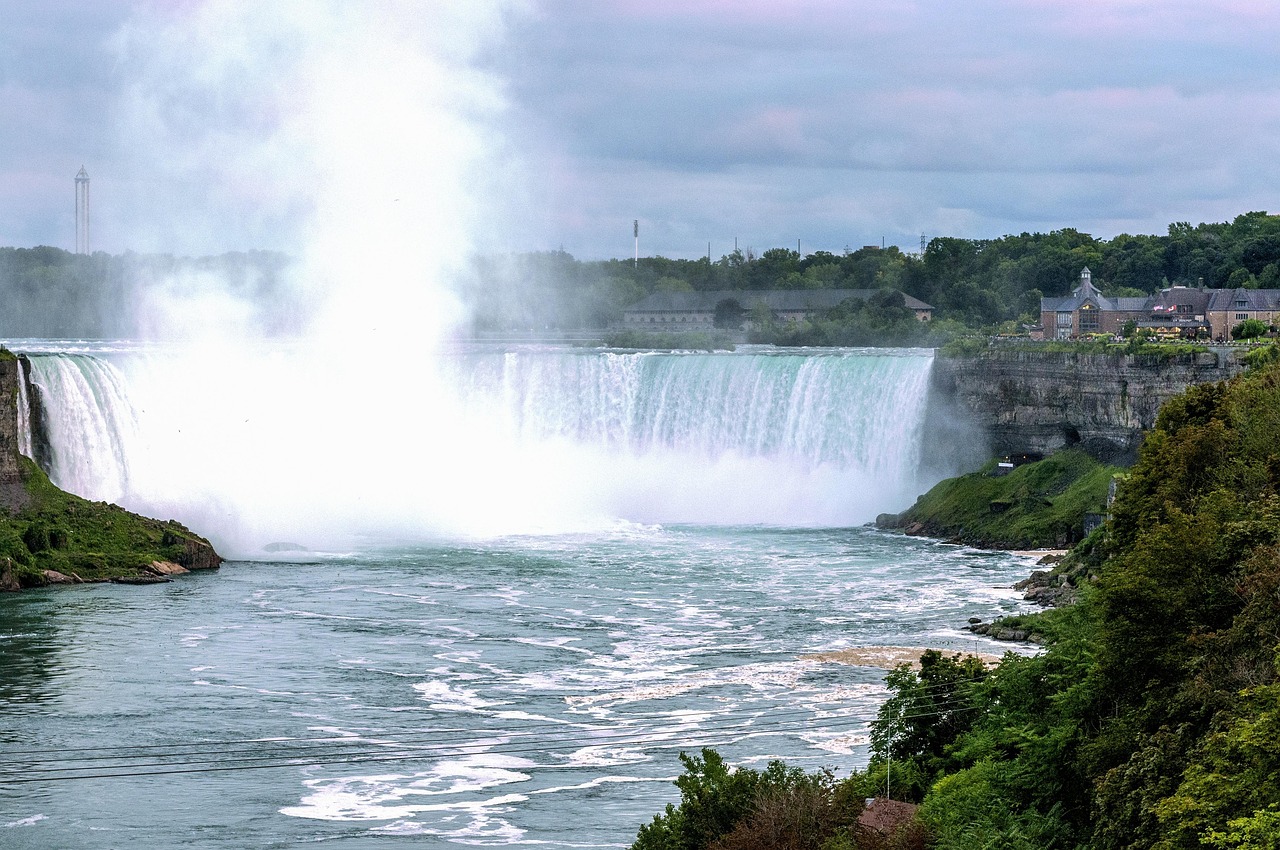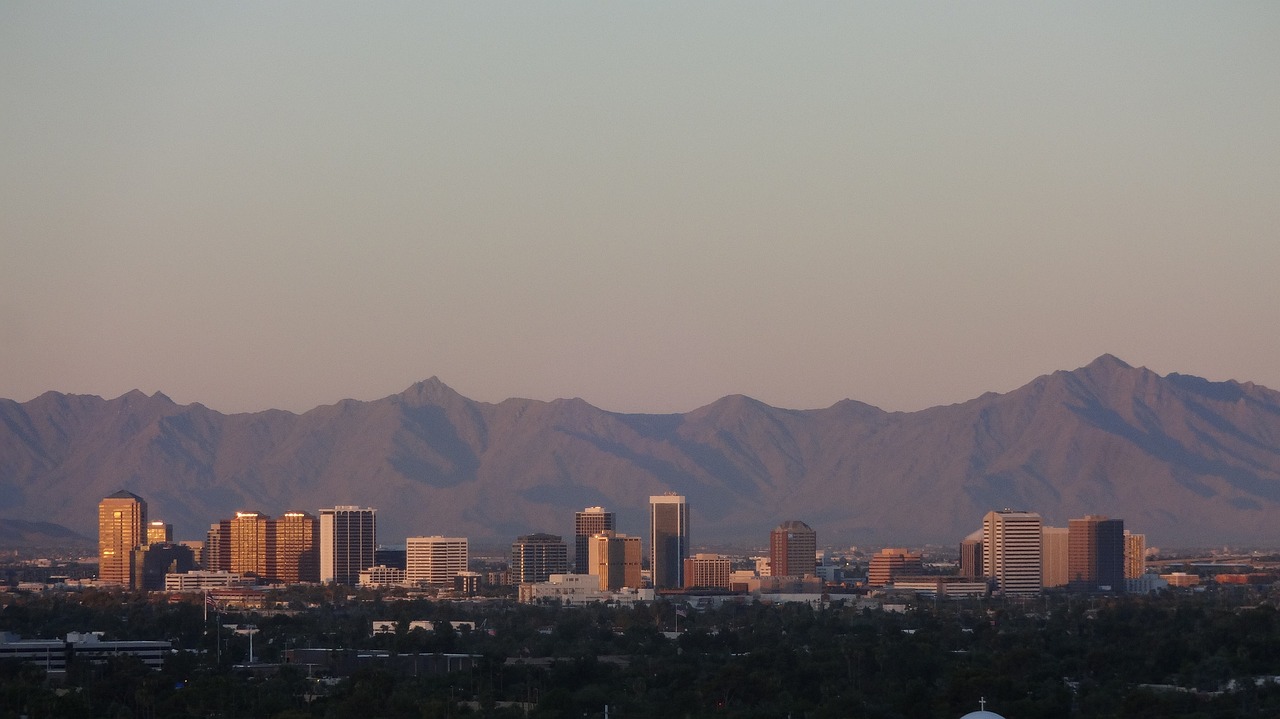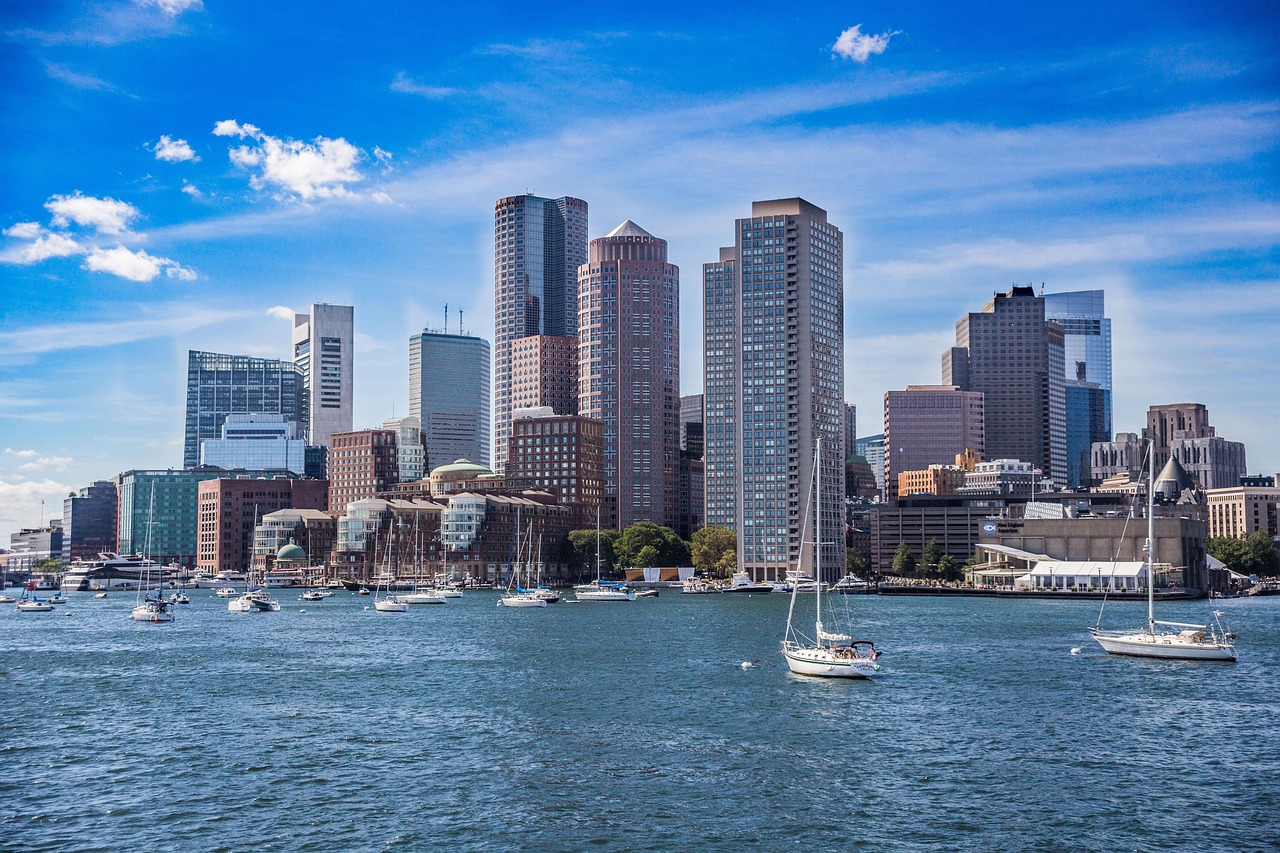Looking for a big adventure? Niagara Falls is one of the most famous waterfalls in the world. This blog will guide you through its beauty, history, and why it’s a must-see. Keep reading to discover more!
Key Takeaways
- Niagara Falls, made up of three waterfalls, lies on the Canada-New York border and is known for its high flow rate.
- It began forming around 12,000 years ago from glaciers and continues to change due to erosion.
- The falls attract millions with attractions like Maid of the Mist boat tours and Cave of the Winds.
- Famous tightrope walkers have performed daring stunts over the falls, adding to its legend.
- Efforts to preserve Niagara involve conservation programs and tackling climate change challenges.
Overview of Niagara Falls
Niagara Falls is a renowned natural wonder located on the border of Canada and New York. Consisting of three distinct waterfalls, namely Horseshoe Falls, American Falls, and Bridal Veil Falls, it attracts millions of tourists annually due to its breathtaking beauty and cultural significance.
Location and significance
Niagara Falls sits on the border between Canada and New York, USA. It’s a massive group of three waterfalls: Horseshoe Falls, American Falls, and Bridal Veil Falls. Together, they form the highest flow rate of any waterfall in North America.
This makes them a key source for hydroelectric power.
These falls are not just about power; they’re major tourism spots too. Millions visit each year to see their beauty up close. Attractions like boat tours and observation towers give people ways to enjoy Niagara from many angles.
For those who love nature, there are parks and trails nearby as well.
The three waterfalls: Horseshoe Falls, American Falls, and Bridal Veil Falls
Horseshoe Falls, mostly on the Canadian side, is the largest of the three. It forms a shape like a horseshoe. This waterfall is very powerful and beautiful. Many visitors come to see it every year.
American Falls and Bridal Veil Falls are smaller but they’re in New York. A small island called Luna Island separates them. They also attract many tourists with their unique looks.
Visitors enjoy boat tours that go close to these waterfalls for an exciting view.
History of Niagara Falls
Niagara Falls has a rich history dating back to early exploration and settlement, eventually becoming a hub for industrial development and hydroelectric power. The falls have played a crucial role in the region’s growth and continue to be a symbol of natural wonder and human ingenuity.
Early exploration and settlement
Explorers and settlers first came to Niagara Falls in the 17th century. Europeans saw the falls for the first time in 1678, when Father Louis Hennepin, a French priest, wrote about them.
People were amazed by his stories. The area around the falls became popular for its beauty and power.
In the 18th century, more people moved here. They built homes, farms, and mills because of the water from the falls. This place was important during wars too. Soldiers used it to send supplies downriver.
Over time, towns grew on both sides of Niagara Falls, one part in New York and another in Canada.
Industrial development and hydroelectric power
In the late 19th century, the industrial revolution brought major changes to Niagara Falls. Entrepreneurs saw an opportunity to harness the power of the falls for electricity production.
The first large-scale hydroelectric plant, built in 1895 by Nikola Tesla and George Westinghouse, demonstrated how water could be used to generate electricity on a massive scale. This initiative rapidly transformed the region and greatly contributed to its economic growth.
Several power plants were subsequently constructed along the Niagara River, with significant advancements made in hydroelectric technology over time. Today, this network of power stations generates a substantial amount of electricity for both New York State and Ontario, Canada.
This development has not only provided sustainable energy but also become an essential part of preserving and protecting this natural wonder for future generations.
Geology and Formation
The creation of the falls started thousands of years ago due to glaciers and geological shifts. Erosion continues to shape the falls, creating future changes in their appearance and structure.
The creation of the falls
Around 12,000 years ago, the formation of Niagara Falls began after the last Ice Age. The falls were carved out by glaciers and water erosion as massive ice sheets retreated. The force of the rushing water from the melting glaciers shaped and molded the landscape over thousands of years, resulting in the awe-inspiring natural wonder that exists today.
This geological marvel is a testament to the power of nature and continues to captivate millions of visitors each year with its breathtaking beauty and sheer magnitude.
The falls are located on the border between Canada and New York, where they continue to be sculpted by erosion from both water and wind. Despite their evolution through time, Niagara Falls remains a powerful symbol of natural wonder and a reminder of our planet’s incredible ability to shape itself into stunning spectacles for all to enjoy.
Erosion and future changes
The formation of Niagara Falls began around 12,000 years ago when glaciers receded, causing meltwater to carve out the Niagara River and eventually these famous waterfalls. The relentless force of water has led to progressive erosion, causing the falls to move upstream at a rate of about one foot per year.
Over time, this constant erosion will lead to the retreat of Horseshoe Falls towards Lake Erie and the eventual disappearance of American Falls.
Climate change poses additional challenges for Niagara Falls. Increased precipitation and higher water levels in the Great Lakes can accelerate erosion, alter flow patterns, and impact the overall appearance of the falls.
To manage these potential changes, ongoing monitoring efforts are crucial in preserving this natural wonder for future generations.
Tourism and Attractions
Tourists flock to Niagara Falls State Park, the oldest state park in the U.S., offering stunning views of the falls and access to attractions like Maid of the Mist boat tours and Cave of the Winds experience.
The Observation Tower provides breathtaking panoramic scenes, while scenic trails allow visitors to immerse themselves in nature’s beauty.
Niagara Falls State Park
Niagara Falls State Park, established in 1885, is the oldest state park in the United States. It spans over 400 acres and offers mesmerizing views of the American Falls, Horseshoe Falls, and Bridal Veil Falls.
The park also provides various attractions such as the Prospect Point Observation Tower, where visitors can take in stunning panoramic views of the falls and surrounding area. Moreover, tourists can explore hiking trails offering breathtaking scenery along the Niagara River Gorge.
In addition to its natural splendor, Niagara Falls State Park offers recreational facilities including an aquarium and adventure-packed experiences like the Cave of the Winds tour which takes visitors closer to Bridal Veil Falls for an exhilarating encounter with nature’s power.
This iconic park attracts around nine million visitors annually who come to witness this remarkable natural wonder and partake in its numerous recreational activities.
Maid of the Mist boat tours
The Maid of the Mist boat tours offer an up-close and thrilling experience at Niagara Falls. Boarding from the New York or Ontario side, visitors don blue rain ponchos and embark on a powerful journey into the misty heart of Horseshoe Falls.
The boats have been operating since 1846, carrying millions of guests to witness this natural wonder from a unique vantage point. It’s a must-do attraction for those seeking an immersive encounter with the falls.
The Maid of the Mist boat tour takes you in proximity to Bridal Veil Falls and American Falls as well, offering an awe-inspiring view of their thunderous cascades. It’s an iconic experience that allows visitors to appreciate the grandeur and power of these majestic waterfalls amidst swirling mist and roaring waters.
Cave of the Winds experience
The Cave of the Winds experience offers a thrilling encounter with the power of Niagara Falls. Visitors can get up close to Bridal Veil Falls, feeling the rush of 20-30 mph winds and surging waters.
This iconic attraction includes a wooden walkway that leads into the gorge, offering an unforgettable view from just feet away from the cascading water. Guests are provided with ponchos and sandals for protection against the mist and spray, ensuring a memorable and immersive experience amidst this natural wonder.
Descending 175 feet into the Niagara Gorge, visitors can witness nature’s raw force as they stand at “Hurricane Deck,” feeling the full impact of thousands of gallons of water crashing down all around them.
The Cave of the Winds has been enticing adventurers since its opening in 1886, making it one of Niagara Falls’ oldest and most revered attractions.
Observation Tower and scenic trails
Prospect Point Observation Tower offers a panoramic view of the falls and Niagara River. It stands at 282 feet, giving visitors a breathtaking vista over the three waterfalls and their surrounding natural beauty.
The tower’s elevators swiftly take you to the top for an unobstructed look at one of the world’s most famous natural sights. Scenic trails wind through Niagara Falls State Park, leading hikers to various viewpoints along the gorge with remarkable views of the falls from different angles.
Visitors can explore these trails on foot or by bike, immersing themselves in lush greenery and stunning vistas while enjoying closer encounters with nature’s majesty.
Moving on to “Cultural and Media Influence”…
Cultural and Media Influence
Movies and literature often feature Niagara Falls, from classic romances to heart-pounding stunts. Read on for fascinating insights into the cultural impact of this natural wonder.
Niagara Falls in movies and literature
Niagara Falls has been featured in various movies and literature, captivating audiences with its stunning beauty. The iconic waterfalls have served as a dramatic backdrop for many films, including “Superman II,” “Pirates of the Caribbean: At World’s End,” and “The Incredible Hulk.” Additionally, authors such as Nathaniel Hawthorne and Henry James have incorporated Niagara Falls into their literary works, emphasizing its majestic grandeur.
This cultural representation showcases the enduring allure of Niagara Falls in the media.
Moving on to famous stunts and tightrope walkers that have added to the falls’ legend…
Famous stunts and tightrope walkers
Famous stunts and tightrope walkers have captivated audiences at Niagara Falls. In 1859, the Great Blondin became the first person to walk across a tightrope stretched above the gorge.
Since then, numerous daredevils have attempted death-defying feats over the falls.
The most famous of these stunts was in 2012 when Nik Wallenda walked on a tightrope over Horseshoe Falls. This drew worldwide attention and made history as he became the first person to walk directly over Niagara Falls.
After “Famous stunts and tightrope walkers,” preservation efforts will be discussed at Niagara Falls.
Preservation and Environmental Efforts
Efforts to preserve Niagara Falls include various conservation programs and addressing challenges from climate change. To learn more about the preservation of this natural wonder, continue reading the blog.
Conservation programs
Conservation programs at Niagara Falls are vital for preserving the natural beauty and ecosystem of this iconic site. Efforts include habitat restoration initiatives, water quality monitoring, and wildlife protection measures.
The Niagara Falls State Park has implemented educational programs to raise awareness about environmental conservation among visitors, focusing on sustainable practices and minimizing human impact on the surroundings.
Additionally, there are ongoing collaborations between governmental agencies and non-profit organizations to maintain the integrity of the park’s diverse flora and fauna.
The conservation efforts also extend to managing visitor activities within the park through designated trails and viewing areas that minimize disruption to local wildlife habitats while providing an enriching experience for tourists.
With climate change presenting new challenges, these programs continue to adapt by incorporating strategies for mitigating its effects on the unique ecosystem of Niagara Falls.
Challenges from climate change
Climate change poses a significant threat to Niagara Falls. The rising temperatures can lead to an increased risk of extreme weather events, affecting the delicate balance of the falls.
Additionally, changes in precipitation patterns and water flow could impact the volume and intensity of the waterfalls, altering their majestic appearance and potentially impacting tourism.
The increasing frequency of heatwaves and severe storms due to climate change also presents challenges for preserving the natural habitats around Niagara Falls State Park. This threatens the diverse plant and animal species that call this area home.
Conservation efforts are crucial in mitigating these risks and ensuring that future generations can continue to enjoy the beauty and wonder of Niagara Falls as we do today.
Plan Your Visit
Plan Your Visit: Discover the best times to visit and explore nearby attractions and dining options. Ready for an adventure? Read on!
Best times to visit
The best times to visit Niagara Falls are during the summer months from June to August when the weather is warm and pleasant. The falls are also beautiful in the fall, especially in September and October, with colorful foliage adding to the natural spectacle.
However, it’s important to note that these periods can be crowded with tourists due to the favorable weather conditions. For a more peaceful experience, consider visiting in late spring or early fall when the crowds are thinner but there’s still good weather.
Niagara Falls sees a decrease in visitors during winter, but if you don’t mind chilly temperatures, you may witness a magical sight as parts of the falls freeze over creating an enchanting wintry landscape.
Keep in mind that some attractions and boat tours may operate on limited schedules during this time.
Nearby attractions and dining options
After enjoying the breathtaking beauty of Niagara Falls, visitors can explore nearby attractions and dining options. Just a short walk from the falls is Niagara Falls State Park, offering scenic trails, an observation tower overlooking the waterfall, and a visitor center with interactive exhibits.
For those interested in marine life, the Aquarium of Niagara is also close by, featuring various aquatic species.
When hunger strikes, there are plenty of dining choices near the falls. From casual cafes to fine dining restaurants, visitors can savor diverse cuisines while overlooking stunning views of the waterfalls.
Additionally, several establishments offer vegan and vegetarian options to cater to different dietary preferences.
Adjacent to the falls is Prospect Point where one can find Top of The Falls Restaurant providing panoramic views of Horseshoe Falls or opt for more casual fare at Prospect Point Café for grab-and-go meals serving local favorites.
Conclusion
Niagara Falls is a captivating natural wonder that captivates visitors from around the world. With its awe-inspiring beauty and breathtaking power, it’s a must-see destination for nature lovers and adventure seekers alike.
Whether you’re taking a boat tour to feel the mist on your face or walking along the scenic trails, Niagara Falls offers an unforgettable experience for everyone who visits. So plan your trip today and be ready to witness one of the most impressive spectacles in North America!
FAQs
1. What makes Niagara Falls special?
Niagara Falls is famous for its stunning beauty and powerful waterfalls. It attracts millions of visitors each year, who come to see the massive rush of water cascading down from great heights.
2. How can I visit Niagara Falls?
You can visit Niagara Falls by car, bus, or train. There are many tours available that take you right to the falls, so you can enjoy breathtaking views and even boat rides close to the water.
3. Are there activities at Niagara Falls?
Yes! At Niagara Falls, you can explore hiking trails, take guided tours, or ride on boats like the Maid of the Mist. You can also enjoy viewing platforms for amazing photographs and experiences.
4. When is the best time to go to Niagara Falls?
The best time to visit is in spring or fall when temperatures are mild and crowds are smaller. However, summer offers lively events and winter showcases beautiful ice formations around the falls.







Leave a Reply